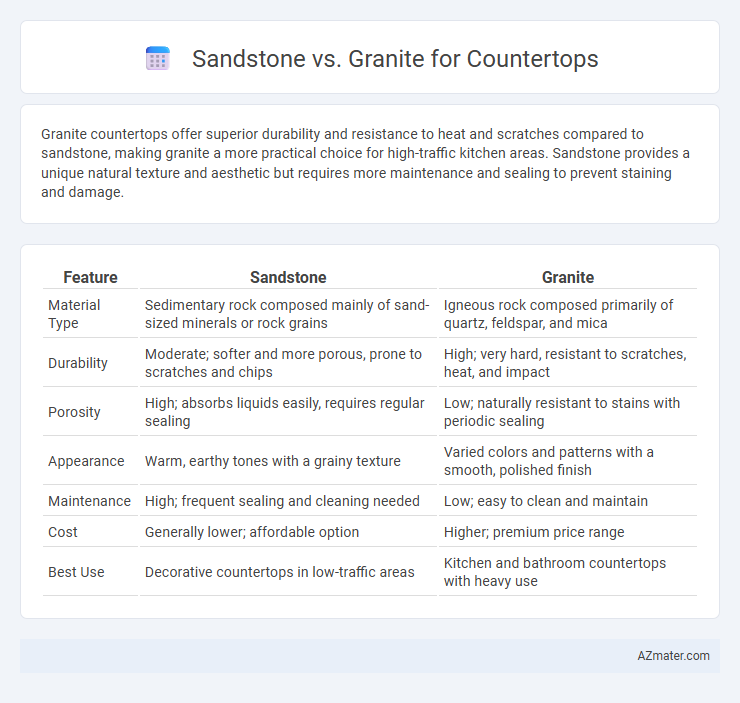Granite countertops offer superior durability and resistance to heat and scratches compared to sandstone, making granite a more practical choice for high-traffic kitchen areas. Sandstone provides a unique natural texture and aesthetic but requires more maintenance and sealing to prevent staining and damage.
Table of Comparison
| Feature | Sandstone | Granite |
|---|---|---|
| Material Type | Sedimentary rock composed mainly of sand-sized minerals or rock grains | Igneous rock composed primarily of quartz, feldspar, and mica |
| Durability | Moderate; softer and more porous, prone to scratches and chips | High; very hard, resistant to scratches, heat, and impact |
| Porosity | High; absorbs liquids easily, requires regular sealing | Low; naturally resistant to stains with periodic sealing |
| Appearance | Warm, earthy tones with a grainy texture | Varied colors and patterns with a smooth, polished finish |
| Maintenance | High; frequent sealing and cleaning needed | Low; easy to clean and maintain |
| Cost | Generally lower; affordable option | Higher; premium price range |
| Best Use | Decorative countertops in low-traffic areas | Kitchen and bathroom countertops with heavy use |
Introduction: Sandstone vs Granite Countertops
Sandstone countertops offer a unique, natural texture with warm, earthy tones, making them ideal for rustic or outdoor kitchen designs. Granite countertops are highly durable, resistant to heat and scratches, and feature a polished, elegant appearance with a wide range of color variations. Both materials require proper sealing, but granite's strength and longevity make it a popular choice for high-traffic kitchen surfaces.
Key Differences Between Sandstone and Granite
Sandstone and granite differ significantly in composition and durability, with granite being an igneous rock composed mainly of quartz, feldspar, and mica, offering superior hardness and resistance to scratches and heat. Sandstone, a sedimentary rock made of compacted sand grains, tends to be softer and more porous, requiring regular sealing to prevent staining and damage. Granite countertops are more suitable for high-traffic kitchen use due to their toughness and low maintenance, while sandstone countertops provide unique textured aesthetics but demand careful upkeep.
Appearance and Color Variations
Sandstone countertops offer a warm, earthy appearance with natural textures and subtle color variations ranging from beige to reddish-brown, creating a rustic and inviting ambiance. Granite countertops exhibit a more polished and luxurious look with a wide spectrum of color options, including black, white, green, and blue, featuring intricate grain patterns and speckles that enhance visual depth. The choice between sandstone and granite depends on the desired aesthetic, with sandstone emphasizing natural, matte finishes and granite providing vibrant, glossy surfaces.
Durability and Hardness Comparison
Granite outperforms sandstone in durability and hardness, making it a superior choice for countertops in high-traffic kitchens. With a Mohs hardness rating of 6 to 7, granite resists scratches, heat, and stains more effectively than sandstone, which typically ranks around 6 or lower and is more porous. The dense crystalline structure of granite contributes to its longevity and scratch resistance, while sandstone's sedimentary composition leads to greater susceptibility to wear and etching.
Maintenance Requirements
Sandstone countertops require regular sealing and more frequent maintenance due to their porous nature, which makes them susceptible to staining and damage from acidic substances. Granite countertops are more durable and resistant to scratches and stains, needing only periodic sealing to maintain their appearance and functionality. Both materials benefit from gentle cleaning with non-abrasive products to prolong surface integrity.
Stain and Heat Resistance
Granite countertops offer superior stain and heat resistance due to their dense, non-porous surface, making them ideal for kitchen use where spills and hot pots are common. Sandstone, being more porous, requires sealing to resist stains effectively and is less heat resistant, prone to discoloration and damage from high temperatures. Choosing granite ensures greater durability and easier maintenance for stain and heat exposure compared to sandstone.
Cost Analysis: Sandstone vs Granite
Sandstone countertops typically cost between $40 and $70 per square foot, offering a more budget-friendly option compared to granite, which ranges from $60 to $100 per square foot. Granite's higher price reflects its superior durability, resistance to scratches and heat, and extensive color variations that add value to kitchen designs. Homeowners should weigh initial installation costs against long-term maintenance expenses, as sandstone may require more frequent sealing and repairs, impacting overall cost-effectiveness.
Installation Process and Considerations
Sandstone countertops require careful sealing and professional installation due to their porous nature and softness, which makes them more prone to chipping and staining compared to granite. Granite, being denser and more durable, allows for precise edging and easier handling during installation, with less risk of damage but often demands heavier support structures due to its weight. Both materials necessitate skilled installers familiar with their specific cutting, sealing, and maintenance requirements to ensure longevity and aesthetic appeal in kitchen or bathroom applications.
Environmental Impact and Sustainability
Sandstone countertops, derived from sedimentary rock, generally have a lower environmental impact due to less energy-intensive quarrying and processing compared to granite, which is an igneous rock requiring more energy to extract and polish. Granite's durability and longevity contribute to sustainability by reducing the need for frequent replacements, while sandstone's softer composition often leads to shorter lifespan and higher maintenance. Choosing locally sourced stone, whether sandstone or granite, further minimizes carbon footprint by reducing transportation emissions.
Choosing the Best Stone Countertop for Your Needs
Granite countertops offer superior durability and resistance to scratches and heat, making them ideal for busy kitchens that require long-lasting surfaces. Sandstone provides a unique, natural texture with warm, earthy tones that appeal to those seeking a rustic or vintage look but requires more maintenance due to its porous nature. Selecting the best stone countertop depends on balancing factors like durability needs, aesthetic preferences, and maintenance commitment to ensure the surface fits the lifestyle and design goals.

Infographic: Sandstone vs Granite for Countertop
 azmater.com
azmater.com